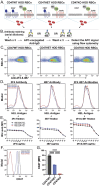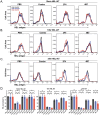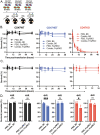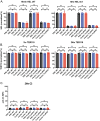CD47 regulates antigen modulation and red blood cell clearance following an incompatible transfusion
- PMID: 40255405
- PMCID: PMC12006802
- DOI: 10.3389/fimmu.2025.1548548
CD47 regulates antigen modulation and red blood cell clearance following an incompatible transfusion
Abstract
Red blood cell (RBC) alloantibodies can result in the rapid removal of incompatible RBCs following transfusion. However, antibody-mediated clearance of RBCs is not the inevitable outcome of an incompatible transfusion. Antibody engagement can also result in the modulation of the target antigen, often rendering RBCs resistant to antibody-mediated removal. Despite this, the factors that regulate antibody-induced RBC removal or antigen modulation remain incompletely understood. Given the ability of CD47 to regulate RBC survival in general, we examined the possible role of CD47 in governing antibody-mediated RBC clearance and antigen modulation. This was achieved by crossing the well-established HEL-OVA-Duffy (HOD) mouse model with CD47 knockout (KO) mice to generate offspring that express the HOD antigen and either WT (HOD CD47 WT), heterozygote (HOD CD47 HET) or KO (HOD CD47 KO) levels of CD47. Using the commonly employed anti-HEL immunization model, our results demonstrate that while antibody engagement of HOD CD47 WT RBCs resulted in rapid antigen modulation in the absence of detectable RBC clearance, antibody binding to HOD CD47 HET RBCs did result in detectable RBC removal despite similar rates and overall levels of antigen modulation. In contrast, despite accelerated clearance of HOD CD47 KO RBCs in the absence of anti-HEL antibodies, the rate of RBC removal and antigen modulation was enhanced in the presence of anti-HEL antibodies. Taken together, these results suggest a role for CD47 in regulating the overall consequence of an incompatible RBC transfusion.
Keywords: alloimmunization; antibodies; antigen modulation; incompatible transfusion; red blood cell.
Copyright © 2025 Jajosky, Covington, Liu, Chai, Zerra, Chonat, Stowell and Arthur.
Conflict of interest statement
The authors declare that the research was conducted in the absence of any commercial or financial relationships that could be construed as a potential conflict of interest.
Figures







Similar articles
-
Dynamics of antibody engagement of red blood cells in vivo and in vitro.Front Immunol. 2024 Nov 28;15:1475470. doi: 10.3389/fimmu.2024.1475470. eCollection 2024. Front Immunol. 2024. PMID: 39669570 Free PMC article.
-
IgG2b enhances alloantibodies to stored red blood cells.Transfusion. 2025 Aug;65(8):1408-1417. doi: 10.1111/trf.18306. Epub 2025 Jun 9. Transfusion. 2025. PMID: 40485608
-
Marginal zone B cells mediate a CD4 T-cell-dependent extrafollicular antibody response following RBC transfusion in mice.Blood. 2021 Aug 26;138(8):706-721. doi: 10.1182/blood.2020009376. Blood. 2021. PMID: 33876205 Free PMC article.
-
Transfusion thresholds for guiding red blood cell transfusion.Cochrane Database Syst Rev. 2021 Dec 21;12(12):CD002042. doi: 10.1002/14651858.CD002042.pub5. Cochrane Database Syst Rev. 2021. PMID: 34932836 Free PMC article.
-
HLA Class II regulation of immune response in sickle cell disease patients: Susceptibility to red blood cell alloimmunization (systematic review and meta-analysis).Vox Sang. 2022 Nov;117(11):1251-1261. doi: 10.1111/vox.13351. Epub 2022 Sep 14. Vox Sang. 2022. PMID: 36102140 Free PMC article.
References
MeSH terms
Substances
Grants and funding
LinkOut - more resources
Full Text Sources
Research Materials

